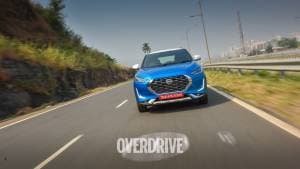Comparison review: Nissan Magnite vs Toyota Urban Cruiser
We seem to have now reached a stage where just saying you want a compact SUV isn't enough. There's an insatiable appetite for SUVs to be filled, and carmakers have been going about filling every niche. The newest entrant to the scene, the Nissan Magnite, is the best example of this. It aims to recreate all the aura around owning a compact SUV but at a more affordable price point. But what is it like when pitted against the segment yardstick, or at least a proxy for it, in the form of the equally new Toyota Urban Cruiser?

Nissan Magnite vs Toyota Urban Cruiser Styling
With the Urban Cruiser, Toyota has brought some more individuality to its version of the Vitara Brezza. Where the Glanza just swapped badges, the Urban Cruiser features a new front-end. The clearly Fortuner-inspired twin-slat grille between the carried over LED headlamps and the large triangular foglamp housings in the bull-bar effect bumper make for the typically butch face that someone shopping in this segment might take a liking to.
We only wish Toyota had done a bit more to the rear, even a more distinguishable revised bumper design would have let the Urban Cruiser stand out from the swarms of Vitara Brezzas already on our roads. But it helps that the Vitara Brezza tows such a straightforward line with its looks, the changes to the Urban Cruiser are effective and seem quite cohesive with the blocky, upright shape of the donor car.


The Nissan Magnite is more of an extrovert. The full-faced grille with the large L-shaped DRLs makes it stand out in a crowd immediately. There is a sharp-cut bonnet to accentuate this but adding a more premium touch is the sleek metalwork, especially the deep creases flowing into the bonnet and the heavily bulged rear three-quarter section which melds into the taillamps. The funnelled roof design is another nice touch, and even from the rear, the Magnite does a pretty convincing job of making itself look like a fully-formed SUV, even if it can't quite capture the no-nonsense appeal of the Toyota.
We noticed some misaligned panels but other than that the details like the standard 16-inch wheels, layered body cladding, and bright dual-tone paint options drive this sense home further. We only wish the tail lamps were LED too, these would have rounded off the premium feel that the Magnite otherwise recreates.


Nissan Magnite vs Toyota Urban Cruiser interiors and features
We already know the Renault-Nissan CMF-A+ architecture to be exceptionally space-efficient from the Triber, and the new Nissan is another example of this. Both SUVs share the same 2,500mm wheelbase but even with it being narrower and shorter, the Magnite gives very little away to the Toyota in terms of interior space. With its shape, the Magnite can't quite match the high-riding, airy feel of the Urban Cruiser but in terms of usable space, the Nissan runs the Toyota very close with generous shoulder and knee room, both front and rear. The seats themselves are also quite a bit more supportive in the Magnite, better contoured and with more under-thigh support.
Just like its looks, the Urban Cruiser's interiors will appeal to those who are looking for a sedate place to spend time in, being a straight lift from the Brezza. The simple dash has aged well with all the controls falling to hand easily and the brown upholstery unique to the Toyota adding some degree of luxuriousness. You wouldn't usually say this of a Maruti-built product in this segment, but with the starkly hard plastics in the Magnite, the Urban Cruiser manages to convey a sense of solidity here.


That said, the layered surfacing with the hexagonal vents and patterned dash face add some perception of quality to the Magnite. More importantly, all the touchpoints like the armrest and door pads are soft feeling, adding to this effect. The layered centre console angled towards the driver and large door bins bring with them a dollop more practicality too. Both offer a 60:40 split rear seat, but the Magnite's low loading lip makes this space easier to access.
But where the Magnite impresses is with its massive list of features, many of them unseen before in this segment. The must-have Tech Pack, a Rs 40,000 option on the top two trims, adds wireless charging, JBL audio, an air purifier and even puddle lamps as highlights. But even without this, the Magnite is brim-full of amenities. The most useful one in our book is the wireless Android Auto/Apple Carplay which works reasonably well with the 8-inch touchscreen.


The Urban Cruiser offers wired phone mirroring with its smaller 7-inch unit, although we think the Maruti system is one of the easier ones to get your head around. Another big draw with the Nissan is its 7-inch digital instrument cluster, with its crisp graphics and intuitively put-forth information. In stark contrast are the simple dials from the Urban Cruiser and the small single colour MID between them. Both SUVs here offer climate control and cruise control, although the Toyota adds a very useful auto-dimming rear-view mirror and auto headlamps while Nissan brings with it phone-based connected-car tech and rear AC vents.


Nissan Magnite vs Toyota Urban Cruiser engine, gearbox and efficiency
Again, the Urban Cruiser and Magnite are distinctly different in execution. The Toyota uses Suzuki's familiar K15B powertrain, making 105PS and 138 Nm. Our tester paired this with a mild-hybrid integrated starter generator and a 4-speed torque converter automatic. As always we came away impressed with this motor's linearity from the electrical assistance and its refinement. Although, the old-fashioned gearbox saps some of the eagerness we've liked from the engine when paired with a manual. But in regular, part-throttle city driving the gearbox is largely unintrusive. It keeps the engine in its powerband more often than not, even if the shifts themselves aren't lightning quick, and there is straightforward progress to be made. It's only under heavier loads like up a slope or out on the highway that the gearbox falls short. The unit is sometimes overeager to downshift here or can take longer to react when asked for more grunt. The lack of a fifth or sixth gear is most apparent on a highway cruise with the engine hovering around 2,500 rpm at 100 kmph. But even with this, in the vein of a true Maruti, the Urban Cruiser is much more efficient than the turbo-ed Nissan.


The Magnite is a more contemporary experience from behind the wheel. It debuts Renault-Nissan's HRA0 1.0-litre three-cylinder turbo-petrol engine in the Indian market with 100PS and 152 Nm. Despite there being not much between the two SUVs on paper, the Magnite is much brisker in practice, doing the 0 to 100 kmph run in 12.5s - more than a second quicker than the Urban Cruiser. There is some noticeable three-cylinder vibrations felt through the steering wheel and pedals at idle but this fades away once you're on the move. It's not the most exciting out of the new turbo-petrols that have flooded this segment now with its quite flat power delivery, but there is strong and consistent mid-range punch. But like most such engines power trails off in the high reaches of the rev-band, quite unlike the Toyota. But as our in-gear time suggests this makes for quick progress at city speeds.
The real highlight though is the CVT this engine pairs with here. We came away impressed with this unit in the Duster turbo and it is similarly appealing here with a sense of seamlessness only good CVTs can muster. There is just a hint of the rubber-band effect here when you are hard on the throttle, where it can't quite mask the engine's lag like the best auto boxes out there. Otherwise, the gearbox will always choose the right ratio generally, feeling much more intuitive than the Urban Cruiser in the city or on the open road.

Nissan Magnite vs Toyota Urban Cruiser ride and handling
Pairing quite well with the relatively sophisticated drivetrain in the Magnite is the way it feels on the move, at least initially. There is a bit of heft to the steering at low speeds but it feels progressive and nice to hold. The 16-inch tires are the same size as those on the Urban Cruiser but add a slightly stiff edge to the ride, although bumps and potholes are handled with a roundedness that makes this SUV quite comfortable as a city car. The Urban Cruiser comes close to matching this feel on smooth surfaces but is let down by steering that feels inconsistently weighed and by damping that can't quite cancel out sharp potholes like the Nissan.

Things are flipped the other way around once you get a move on. At triple-digit speeds, neither feel very well tied down to the road, especially when one-up over high speed sweeping turns. But the Toyota is more consistent in its body movements and reasonably confidence-inspiring with enough seat time. The Magnite though starts to feel inconsistent in the way the steering reacts with the front wheels at different speeds. There seems to be a delay in a steering input resulting in a direction change, which seems to then disbalance the SUV. But slow down a bit and both are pretty good at staying poised.
The Magnite's brakes are a bit more progressive in regular operation, the regen from the mild-hybrid sapping some of the initial pedal feel from that of the Urban Cruiser. Although both stop in similar distances under panic braking, the Magnite slightly better, the Toyota is a bit more confidence-inspiring in such situations. This is mainly down to the loosely suspended brake pedal in our Magnite test car, which moved around a bit too much under our feet for comfort.
Nissan Magnite vs Toyota Urban Cruiser safety
The Toyota-equivalent Maruti Suzuki Vitara Brezza scored a 4-star rating in the NCAP test while the Magnite has garnered a similar 4-star rating in the ASEAN NCAP. But the Nissan's long list of features extend to its safety credentials as well. There is a fairly legible 360-degree camera, ABS, ESC and the Nissan Vehicle Dynamics Control system that quells understeer. The Urban Cruiser offers a single rear camera and ABS, with a hill-hold function specific to the AT. Both come with a maximum of two airbags.

Nissan Magnite vs Toyota Urban Cruiser verdict
Just like the Vitara Brezza, the Urban Cruiser is a compact SUV you buy as a sensible choice. It looks more 'SUV' than a fair few cars in this segment and is reasonably spacious and comfortable. There are just enough gizmos to keep you occupied, just enough poke from the engine and just enough convenience from the four-speed AT. Its true strengths are its efficiency and the strong warranty and service network that Toyota promises. But at Rs 13.49 lakh (on-road) for this Premium-grade dual-tone AT, you have the option of more sophisticated rivals from Hyundai-Kia. More pertinently, the Magnite is a full Rs 2 lakhs less at Rs 11.34 lakh for the top-trim. Even if you factor in the Tech Pack and the clearly budget fitments and dynamics, this is the more compelling buy with its striking looks, impressive drivetrain and massive features list.
Starts Rs 8.4 Lakhs
1499cc
Automatic
105
138
18.76 Kmpl
Starts Rs 5.59 Lakhs
999cc
CVT
100
152
17.7 Kmpl














